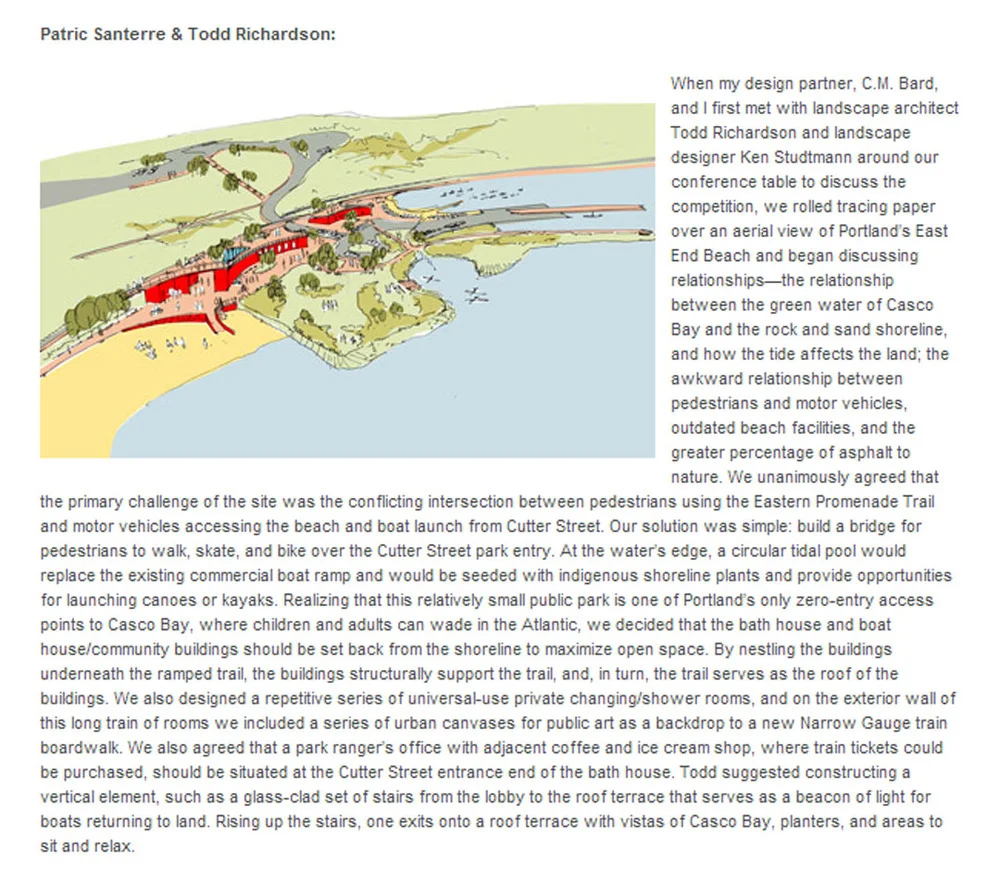ARCADIA Press
Maine Home + Design
The winners of the AIA Ideas Competition share their concepts for Portland’s East End Beach
March 2010
Patric Santerre (right), architect and industrial designer at ARCADIA designworks, and intern Anya Timchenko prepare data so a MakerGear M2 printer can create a window lock mechanism.
Portland’s Eastern Promenade on a sunny summer afternoon is the stuff postcards are made of: dazzling views of the islands and waters of Casco Bay. An Olmsted Brothers–designed park with broad, green lawns, perfect for lying on; trails filled with dogs and strollers; the sound of the Narrow Gauge Railroad horn; monuments honoring history. Of course, there are the less picturesque but necessary elements of a waterside park as well: access roads and parking; boat ramps and storage racks; toilets and changing rooms.
AIA Maine recently hosted an Ideas Competition to solicit visions for improvements to the waterside lands and facilities of the East End Beach.
The goal was to generate ideas that would create safer, more sustainable, and attractive community facilities and open spaces that will serve, encourage, and complement the land- and water-based activities that converge at the site.
Two winning concepts rose to the top from Kevin Moquin and Tony Cowles (Award of Excellence winners) and Patric Santerre of Arcadia Designworks and Todd Richardson of Richardson and Associates (Honor Award winners). Here, the two teams explain their visions for this promising public landscape.
Kevin Moquin & Tony Cowles:
Rooted in the historic significance of an Olmsted-designed waterfront, we wanted to enhance the rich pedestrian experience for both land- and water-based activities. We also sought to rectify the current imbalance between pedestrian and vehicle space. Building on the proximity of the site to downtown Portland, we proposed improvements that would offer respite for urban dwellers while simultaneously providing a progressive vision for the City of Portland. We used the simple geometry of the arc and the line to create a framework on which to build. We used the arcing wall to bisect the site and separate vehicles from the primary pedestrian space. To heighten the sense of arrival, we designed a place that welcomed visitors through a pause in the arc with bold architectural volumes and generous outdoor spaces. In keeping with an understated waterside vernacular, we maintained transparency to the waterfront, while creating an engaging sense of place. The line of boardwalk cutting through the site creates an opportunity for connections to the larger landscape and Casco Bay. Deck outcroppings anchored in the land become extensions of the site geometry that offer both prospect and refuge from the elevated promontories along the pedestrian pathway. An artificial island in the bay is the waterside termination of the boardwalk. As a whole, the boardwalk element is an architectural expression that underscores the experience of land meeting sea. The layering of architectural elements and landscape forms is reminiscent of historic wharves of the working waterfront, while offering varied areas of shelter that respond to our varied climate. A generous ramp and stairs provide improved access to the beach for people of all abilities, while an adjacent deck between beach and plaza offers a comfortable overlook for people watching, events, and socializing. With their orientation to Casco Bay, the buildings provide indoor/outdoor function space that can accommodate large gatherings and recreation-based events. The structures would showcase energy-efficient technologies such as solar thermal hot-water systems, photovoltaic energy supply, and regional materials. To de-emphasize the presence of cars on the site, we took the unconventional approach of creating a “parking grove.” This element provides ample parking but also defers to more critical site attributes such as waterfront access, kayak launching, swimming events, etc.
Patric Santerre & Todd Richardson:
When my design partner, C.M. Bard, and I first met with landscape architect Todd Richardson and landscape designer Ken Studtmann around our conference table to discuss the competition, we rolled tracing paper over an aerial view of Portland’s East End Beach and began discussing relationships—the relationship between the green water of Casco Bay and the rock and sand shoreline, and how the tide affects the land; the awkward relationship between pedestrians and motor vehicles, outdated beach facilities, and the greater percentage of asphalt to nature. We unanimously agreed that the primary challenge of the site was the conflicting intersection between pedestrians using the Eastern Promenade Trail and motor vehicles accessing the beach and boat launch from Cutter Street.
Our solution was simple: build a bridge for pedestrians to walk, skate, and bike over the Cutter Street park entry. At the water’s edge, a circular tidal pool would replace the existing commercial boat ramp and would be seeded with indigenous shoreline plants and provide opportunities for launching canoes or kayaks.
Realizing that this relatively small public park is one of Portland’s only zero-entry access points to Casco Bay, where children and adults can wade in the Atlantic, we decided that the bath house and boat house/community buildings should be set back from the shoreline to maximize open space. By nestling the buildings underneath the ramped trail, the buildings structurally support the trail, and, in turn, the trail serves as the roof of the buildings. We also designed a repetitive series of universal-use private changing/shower rooms, and on the exterior wall of this long train of rooms we included a series of urban canvases for public art as a backdrop to a new Narrow Gauge train boardwalk. We also agreed that a park ranger’s office with adjacent coffee and ice cream shop, where train tickets could be purchased, should be situated at the Cutter Street entrance end of the bath house. Todd suggested constructing a vertical element, such as a glass-clad set of stairs from the lobby to the roof terrace that serves as a beacon of light for boats returning to land. Rising up the stairs, one exits onto a roof terrace with vistas of Casco Bay, planters, and areas to sit and relax.
American Institute of Architects
Maine AIA: aiamaine.org, 207-885-8888
Kevin Moquin, AIA, and Tony Cowles: 207-865-2281, 207-772-1552
Arcadia Designworks: arcadiadesignworks.com, 207-347-5252
Richardson & Associates: richardsonassociates.com, 207-286-9291

